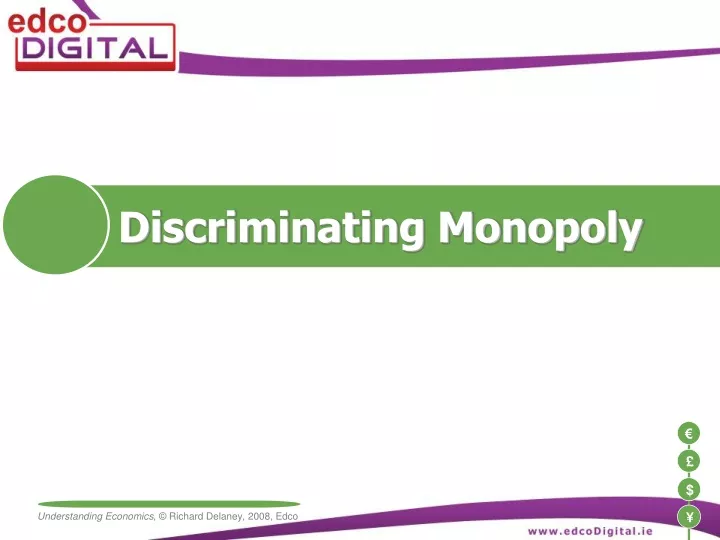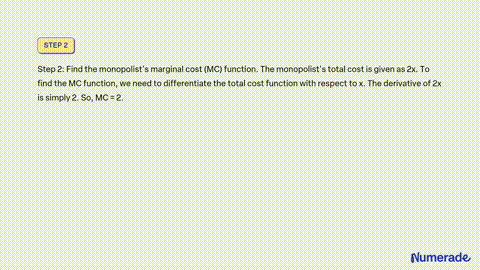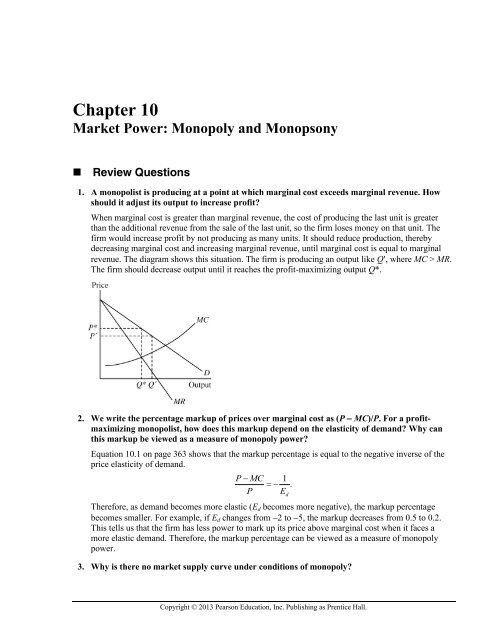Suppose a monopolist discovers a way to perfectly price-discriminate. What is consumer surplus under this scenario? What are the efficiency costs? Solution Verified Answered 2 years ago Create a free account to view solutions Recommended textbook solutions Microeconomics 2nd Edition • ISBN: 9781260152616 (1 more) Dean Karlan, Jonathan Morduch
SOLVED: Suppose a monopolist discovers a way to perfectly price-discriminate. Under this scenario, consumer surplus is negative. What are the efficiency costs (deadweight loss)? Zero.
To summarize, the monopolist’s power to perfectly price discriminate enables them to maximize their profits and simultaneously eliminate any efficiency costs or deadweight loss, so the answer is c. zero. Learn more about Perfect Price Discrimination here: brainly.com/question/32466368 #SPJ11 Advertisement Still have questions? Find more answers

Source Image: slideserve.com
Download Image
5 years ago At the end of this video, Sal states that the extreme example of a firm using price discrimination is allocatively efficient (AE) because, “MR = MC.” I found this confusing because all profit-maximizing firms produce where MR=MC, but it’s not necessarily AE. What would be a better phrasing/explanation for why it’s AE? Thanks!
Source Image: coursehero.com
Download Image
Solved Suppose a monopolist discovers a way to perfectly | Chegg.com
Suppose a monopolist discovers a way to perfectly price-discriminate. Under this scenario, consumer surplus is (Click to select) negative zero positive . … All replies. Answer. 13 days ago. Consumer Surplus in Perfect Price Discrimination When a monopolist practices perfect price discrimination, they charge each consumer the maximum price

Source Image: slideshare.net
Download Image
Suppose A Monopolist Discovers A Way To Perfectly Price-Discriminate
Suppose a monopolist discovers a way to perfectly price-discriminate. Under this scenario, consumer surplus is (Click to select) negative zero positive . … All replies. Answer. 13 days ago. Consumer Surplus in Perfect Price Discrimination When a monopolist practices perfect price discrimination, they charge each consumer the maximum price
Suppose a monopolist discovers a way to perfectly price-discriminate. Under this scenario, consumer surplus is (Click to select) negative zero positive . What are the efficiency costs (deadweight loss)? (Click to select) positive zero negative . 0 All replies Answer 1 month ago
5. what do we worry about when we worry about price discrimination. | PDF
Suppose a monopolist discovers a way to perfectly price-discriminate. … If the performing arts center can perfectly price-discriminate and charge students, staff, and faculty three separate prices, what are its profits? a. 35 b. 9500 c. 12300 d. 13800. See an expert-written answer!
SOLVED: Suppose a monopolist discovers a way to perfectly price-discriminate. Under this scenario, consumer surplus is negative. What are the efficiency costs (deadweight loss)? Zero.

Source Image: numerade.com
Download Image
Chapter 12: Monopoly
Suppose a monopolist discovers a way to perfectly price-discriminate. … If the performing arts center can perfectly price-discriminate and charge students, staff, and faculty three separate prices, what are its profits? a. 35 b. 9500 c. 12300 d. 13800. See an expert-written answer!

Source Image: yumpu.com
Download Image
SOLVED: Suppose a monopolist discovers a way to perfectly price-discriminate. Under this scenario, consumer surplus is negative. What are the efficiency costs (deadweight loss)? Zero.
Suppose a monopolist discovers a way to perfectly price-discriminate. What is consumer surplus under this scenario? What are the efficiency costs? Solution Verified Answered 2 years ago Create a free account to view solutions Recommended textbook solutions Microeconomics 2nd Edition • ISBN: 9781260152616 (1 more) Dean Karlan, Jonathan Morduch

Source Image: numerade.com
Download Image
Solved Suppose a monopolist discovers a way to perfectly | Chegg.com
5 years ago At the end of this video, Sal states that the extreme example of a firm using price discrimination is allocatively efficient (AE) because, “MR = MC.” I found this confusing because all profit-maximizing firms produce where MR=MC, but it’s not necessarily AE. What would be a better phrasing/explanation for why it’s AE? Thanks!

Source Image: chegg.com
Download Image
Chapter 15 MC Section 1
Figure 9.3 The Perceived Demand Curve for a Perfect Competitor and a Monopolist (a) A perfectly competitive firm perceives the demand curve that it faces to be flat. The flat shape means that the firm can sell either a low quantity (Ql) or a high quantity (Qh) at exactly the same price (P). (b) A monopolist perceives the demand curve that it faces to be the same as the market demand curve

Source Image: studylib.net
Download Image
Chapter 10 Market Power: Monopoly and Monopsony
Suppose a monopolist discovers a way to perfectly price-discriminate. Under this scenario, consumer surplus is (Click to select) negative zero positive . … All replies. Answer. 13 days ago. Consumer Surplus in Perfect Price Discrimination When a monopolist practices perfect price discrimination, they charge each consumer the maximum price

Source Image: yumpu.com
Download Image
Price Discrimination
Suppose a monopolist discovers a way to perfectly price-discriminate. Under this scenario, consumer surplus is (Click to select) negative zero positive . What are the efficiency costs (deadweight loss)? (Click to select) positive zero negative . 0 All replies Answer 1 month ago

Source Image: thismatter.com
Download Image
Chapter 12: Monopoly
Price Discrimination
To summarize, the monopolist’s power to perfectly price discriminate enables them to maximize their profits and simultaneously eliminate any efficiency costs or deadweight loss, so the answer is c. zero. Learn more about Perfect Price Discrimination here: brainly.com/question/32466368 #SPJ11 Advertisement Still have questions? Find more answers
Solved Suppose a monopolist discovers a way to perfectly | Chegg.com Chapter 10 Market Power: Monopoly and Monopsony
Figure 9.3 The Perceived Demand Curve for a Perfect Competitor and a Monopolist (a) A perfectly competitive firm perceives the demand curve that it faces to be flat. The flat shape means that the firm can sell either a low quantity (Ql) or a high quantity (Qh) at exactly the same price (P). (b) A monopolist perceives the demand curve that it faces to be the same as the market demand curve